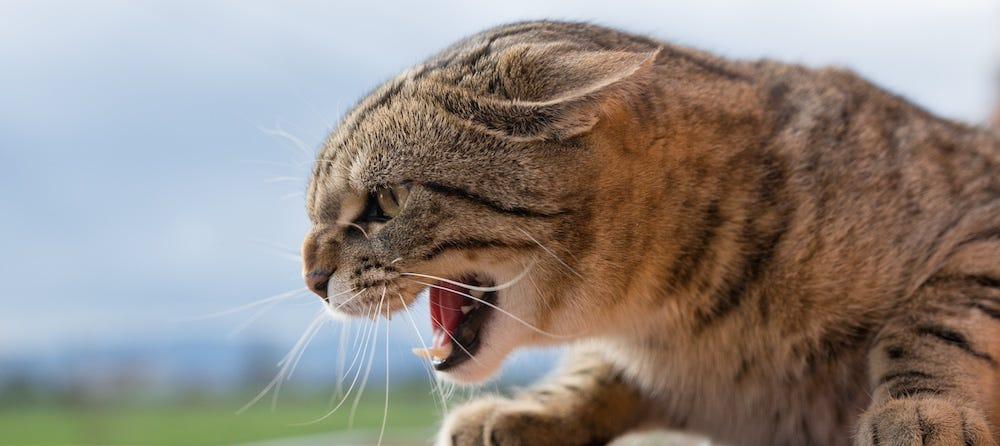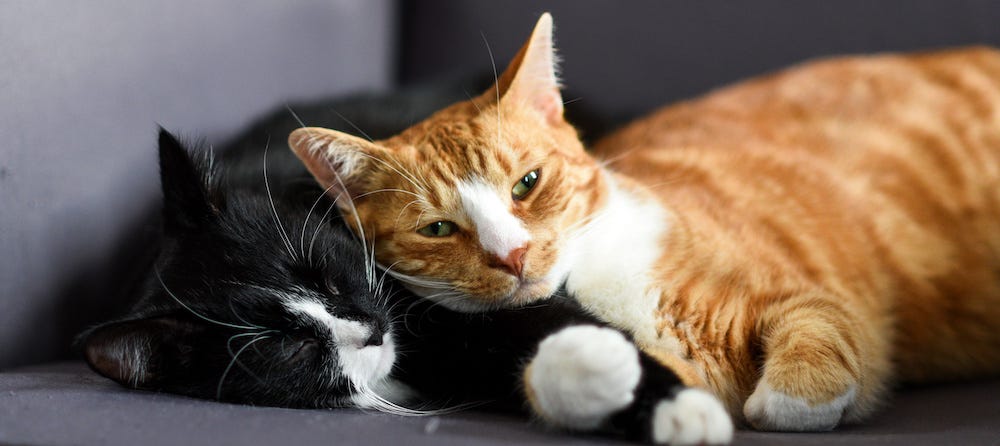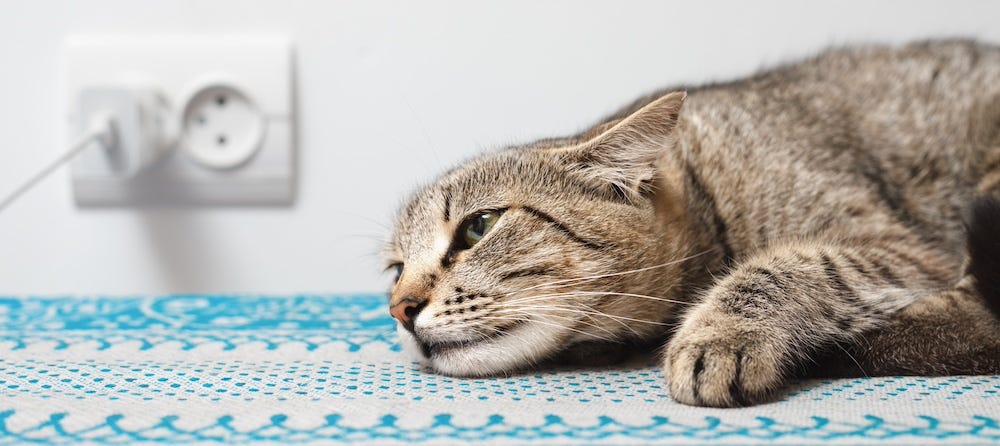Partially authored by Justine Lee, DVM, DACVECC, DABT
What does it mean when your cat becomes aggressive? Aggressive behavior always has a reason behind it, so it’s important to pay attention to what your cat is trying to tell you with their reactive behavior.
Learn about some of the reasons why your cat might become aggressive and how to help nip aggression in the bud.
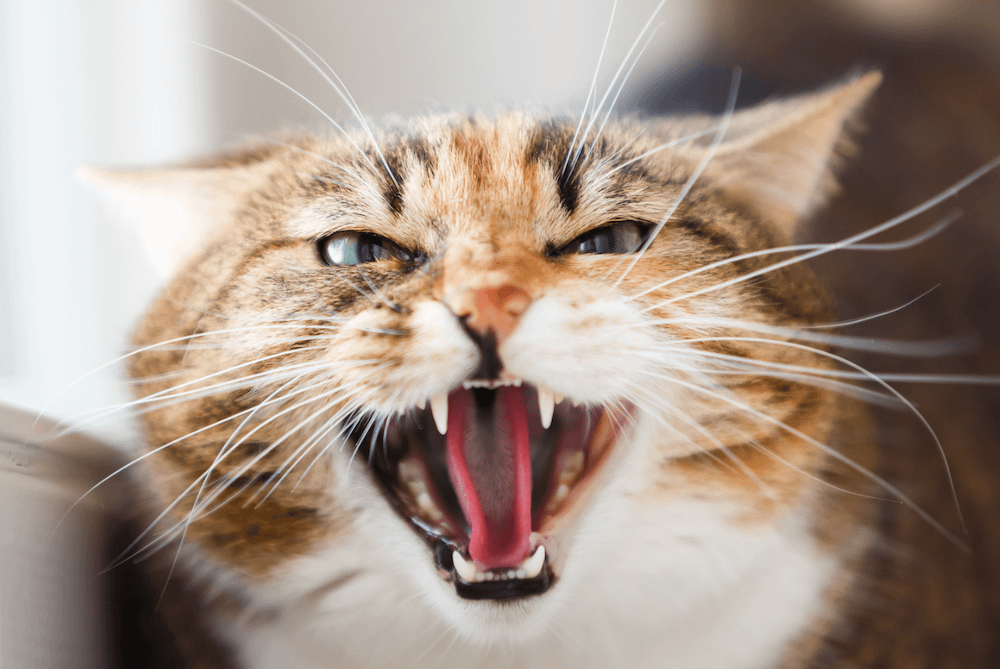
Signs of an aggressive cat
First, let’s define what an aggressive cat looks like—sometimes, it can be confused with a fearful cat! It’s important to be aware of signs of aggression in cats. The sooner you notice your cat’s body language of stress or aggression, the sooner you can break it up or intervene.
Signs of aggression in cats include:
- Ears pinned backward on the head
- Dilated pupils
- An arched back
- A fluffed tail held straight up
- Whiskers held out to the side
- Hissing
- Growling
- Biting
- Exposed claws
Not to be confused with a fearful cat, whose symptoms include some of the above as well as these differences:
- Ears pinned back and held outward
- Lying down with the tail tucked underneath or close to the body
- Whiskers flattened against the face
Now that you understand the body language of cats and know what to look for, please be aware there are several things you can do at home to deal with an aggressive cat.
Is it normal for my cat to be aggressive?
An important thing to understand when it comes to aggressive responses in cats is that this behavior isn’t always pointing to an underlying issue. Aggression can be a natural behavior of your cat’s breed, making it a totally normal response to predation, playfulness, and social conflict. However, when cats start to show aggression towards humans or consistently towards other animals, the frequency of aggression would constitute problematic behavior.
5 reasons why cats behave aggressively
Here are some of the top reasons why your cat is behaving aggressively.
1. Underlying health condition
A number of medical conditions can cause cats to become aggressive. When a cat is in pain, they often will begin lashing out at humans, other animals, or objects near them.
Underlying health conditions that contribute to aggressive behavior can include illnesses like epilepsy, arthritis, dental disease, trauma, and many others. But as stated earlier, if the vet clears your cat and verifies that an underlying cause is not the reason behind your pet’s behavior, you can start considering the following possibilities.
2. Other cats
It’s not uncommon for cats to not cohabitate well. This might include territorial competitions, incompatible temperaments, a lack of socialization, or the consequence of feeling overcrowded. When cats feel intimidated or provoked by other cats, it’s natural for them to go into attack mode. Make sure your cat is comfortable around any other cats in the house. Our guide will help you manage a multi-cat household.
3. Unsafe environments
When cats are feeling threatened, they are going to be on edge, which often causes them to act out. Your cat might be stressed and feeling like there is no safe place for him or her to relax. Cats need their alone time. As such, it’s important for them to have quiet places like cat condos, high shelves, or a special room for them to chill out.
4. Fear
Fear aggression occurs when a cat perceives a threat in his or her environment. It is often accompanied by defensive behavior. The threat could be a person, animal, object, or sound, but no matter the exact threat, cats are more likely to become aggressive when they feel like they can’t escape the perceived threat.
Defensive signs include a crouching stance, flattened ears, a tucked tail, pupil dilation, or a preference for distance. Cats may also show signs of aggressions such as hissing, spitting, growling, swatting, biting, or scratching.
5. Frustration
Redirected aggression is the term used to describe cats that act violently as a result of not being able to reach the object of their frustration. For example, an indoor cat that sees another cat in the yard may become highly reactive because the indoor cat cannot interact with the outdoor cat. Frustration-related aggression can occur over simple things as well, like not getting enough food or attention and being denied access to a favorite place in the house.
Why is my cat suddenly aggressive?
Pain and underlying health conditions are often a reason why cats suddenly behave aggressively. If your cat is showing signs of aggressive behavior and that behavior is out of character, look for potential causes. If there aren’t any obvious causes for your cat’s odd behavior, you should take your pet to the veterinarian so that the vet can rule out any and all underlying medical causes.
Another possibility? If you recently introduced another cat to the household, your kitty may be showing aggression because they were introduced too quickly.
Make sure to introduce cats correctly
First impressions really matter to cats—you want the introduction to go slowly and go well.
If you don’t introduce cats correctly, a lifetime of cat fighting or aggression can ensue.
If for some reason you notice aggression between two particular cats, you should separate them and start all over again. Slowly reintroduce them using positive reinforcement and barriers as needed.
- Start by setting up each of your cats in their own space. This should be behind closed doors where the other cat can’t go.
- Once or twice a day, rotate home base stations for an hour or two.
- Eventually, use a barrier to let them check each other out.
When in doubt, go slow. Remember, first impressions are REALLY key for cats.
For more information, read our vet-authored guide on how to introduce cats.

8 ways to calm an aggressive cat
Making sure your cat has enough space in a safe place where your cat can relax is one of the best ways to calm an aggressive cat. However, there are a few other ways to put your furry friend at ease. If you’re asking the question, “What can you give a cat to calm them down?” we have you covered. Here are a few tips for keeping your cat calm, cool, and collected!
Cat pheromones
Pheromones such a Feliway are a great, cost-effective, safe way of positively influencing your cat’s behavior, as pheromones can ease a cat’s anxiety, reduce stress and stress-related behavior, and help with behavioral problems (like aggression, fighting, etc.). Feline pheromones typically are sold as a wall plug-in, spray (not to be used on your cat directly!), a wipe (on a disposable cloth), or even a collar. In some cases, pheromones alone can solve behavioral issues depending on the severity.
Holistic supplements
But what do you do if there’s no improvement in your cat’s aggression? Next, you can consider some holistic supplements! Veterinary supplements include brands like Zylkene and Solliquin. Zylkene, which contains alpha-casozepine, helps treat fear, anxiety, and stress in cats (it’s a once-a-day pill). Solliquin, which contains l-theanine, phellodendron, and magnolia, can be used twice a day in cats to help support balanced behavior and relaxation.
You can also break out catnip, valerian root, and silver vine, which are stimulants for cats—following the initial excitement, these herbs can provide your cat with a calming sensation.
While CBD options are being explored for cats, please be aware that most cats drool profusely when they get oral CBD—so at this time, vets aren’t a fan of CBD for cats!
Calm response
Your response to your cat’s aggression matters just as much as determining the reason for the aggression. Avoid any type of physical punishment or yelling, as it can increase a cat’s fear or anxiety, ultimately worsening the aggression.
Positive reinforcement
When your cat has calmed down, approach them from the side so you’re less threatening and offer them positive reinforcement like treats or catnip. Food treats are an excellent way to reinforce non-aggressive behavior.
If you’re dealing with cat-on-cat aggression, separate them and reintroduce them slowly with positive reinforcement. When cats sniff out the cat space without hissing, or have a calm, stress-free interaction, give them a treat immediately. If you wait too long (even 5 minutes later) it’s too far of a time gap and your cat won’t make the direct connection with calm behavior and a treat.
Environmental modifications
Sometimes it's as simple as making some environmental adjustments. Make sure your cat has access to:
- An appropriate number of clean litter boxes
- Food and water sources appropriately placed throughout the house
- A climbing perch or the ability to look out the window
No matter what, make sure your cats have their very own safe place to hang out, relax, and spend quiet alone time. A piece of cat furniture can provide a safe and covered space for your cat to hang out in, and it is small enough so that it fits perfectly next to a chair or by the couch.
Veterinary exam
If you’ve tried all that and your cat is still aggressive, a vet check is a must. We need to make sure there aren’t any medical problems that are causing the aggression or altered behavior. Potential medical causes of aggression in cats include:
- Ear infection
- Sore mouth/infected tooth
- Urinary tract infection
- Bladder stones
- Osteoarthritis
- Overactive thyroid gland
- Secondary pain
Once underlying medical problems have been ruled out, a vet-recommended behavioral prescription medication may be necessary.
Prescription medications
Prescription medications often include selective-serotonin reuptake inhibitor (called SSRI) antidepressants; these drugs work by providing more serotonin in the body to relax your cat, and help make your cat calmer, less fearful, and less aggressive. Yes, this is the equivalent of cat Prozac. Reminder: Never give YOUR medications to your cat!
Some cat parents are hesitant to medicate their cat. However, keep in mind that it may be better for your cat’s welfare if the aggression is severe. Other medications may include oral sedatives—these are used more for travel or stress-related matters and include classes of drugs like gabapentin or trazodone. These cause sedation and are really only used prior to veterinary visits, groomer visits, or changes in environment (like if you have family visiting for the holidays, are moving, etc.).
When using oral medications to reduce aggression in your cat, please be aware that it should also be in combination with behavioral and/or environmental modification to be successful.
Veterinary behaviorist
OK, you’ve tried it all. You’ve gone to your vet. Your cat is on drugs. And it’s still not working? It’s time for a pro: the veterinary behaviorist. This isn’t an online trainer—this is a veterinarian who has done an additional 2-3 years of advanced training in the form of a residency program. These veterinarians have the added letters DACVB behind their name, as this stands for a Diplomate of the American College of Veterinary Behavior. While veterinary behaviorists often work with animal trainers—and your veterinarian—these are the pros to go to with severe cases of cat aggression that aren’t responding to the above care. (You can also check out their recent book Decoding Your Cat for general training guidelines for cats too!)
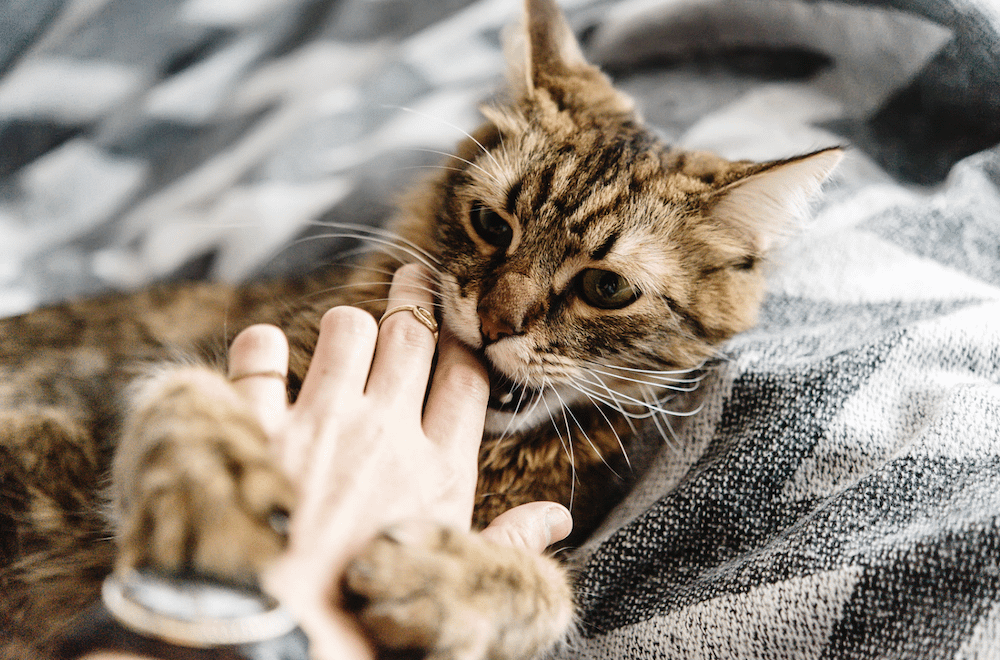
9 tips to prevent aggression in cats
The best way to avoid dealing with an aggressive cat is to prevent it. As a species, cats aren’t very adaptable. They hate any change to their environment and get easily stressed from it, which can lead to secondary behavioral—or even medical—problems.
Make sure that kittens are well socialized
If you’re thinking about adding cats to your household, ideally you want to get two kittens together from the same litter, as they are more likely to get along. If you don’t have a preference for male or female, consider getting two of the same sex, as they often get along better!
Not ready for two kittens? Adding a cat earlier than later is better, as younger cats are more likely to get along than when there’s a large disparity in age or time. If they aren’t littermates, consider a younger male and female, as they often get along better. Avoid the problem of having an aggressive cat to begin with by intervening early.
Avoid creating territorial aggression by spaying or neutering your cat by 5 months of age
This will be important not only to prevent sex hormones from causing unwanted behavioral changes—like urine spraying and fighting—but to help prevent pet overpopulation too!
Avoid using your hands or feet when playing with your cat
Some cats lack social skills and can’t control their claws or teeth and may bite during play. You don’t want your cat to use you as a toy when your cat has play aggression. If you’re playing with your cat and they get aggressive, stop what you’re doing immediately, ignore your cat, and walk away. This may help teach him that play aggression isn’t rewarded and results in “no play time” at all. If you find your cat attacking your hands or feet, direct their attention towards something else, like a wand toy.
Also, please note that you should NEVER use your hand (or human body parts) to separate cats when fighting, as cat bites can cause serious injury and infection. If you need to break up a fight, use something else instead—a broom, piece of cardboard, etc.
Provide a separate safe place for resources for each cat that you have
That way each cat can go somewhere for some alone time. Make sure there are plenty of toys, enough litter boxes (or one self-cleaning litter box), food, a clean water source, and a sleeping area. This will help prevent fighting over resources. Learn more in our guide on managing a multi-cat household.
Consider a food game device that helps stimulate your cat “hunting” for food
This will also provide some environmental enrichment for them.
Remove any stimuli that make your cat aggressive
If you have a stray cat walking up to your window, close the window or use a window shade to prevent them from seeing each other. Likewise, if your cat is on a window perch looking at the stray cat, move your cat to a different area of the house to minimize that stimulation.
Recognize the body language of aggression in cats early
If you start to notice any signs of aggression in your cat, break the cycle by simply startling your cat. No need for physical contact—just a loud clap or blast of spray from a can of compressed air. You can also hiss too—that ought to startle your cat! While our goal isn’t to scare cats, it’s important to distract your aggressive cat to help him “reset.” Again, we never want to use physical punishment, as this will make your cat fearful of you or result in other abnormal behavior.
Protect your other cat
If you have a more submissive cat who is the brunt of attack, please make sure to protect him or her.
- Make sure you are there to supervise them, and if you’re not home, consider adding a barrier (like a baby gate, separate room, etc.).
- Make sure all your cats’ nails are trimmed at least monthly, to minimize the severity of injury.
- Consider adding a bell on a cat breakaway collar so your other cats know where the attacker may be too!
Talk to your veterinarian sooner rather than later
We know that underlying medical problems can cause aggression in cats. The biggest mistake vets see people trying at-home remedies first, only to get frustrated in failure. When in doubt, consult with your veterinarian early to get help with environmental modification, ruling out medical problems, trying natural holistic supplements, and pharmacologic intervention for help.
